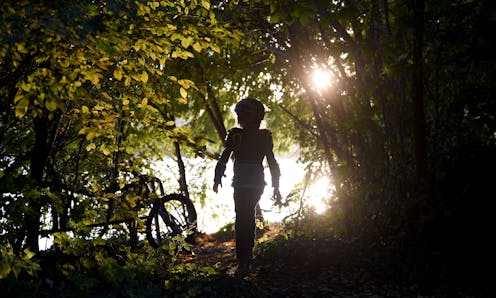Connecting to nature is good for kids – but they may need help coping with a planet in peril
- Written by Louise Chawla, Professor Emerita of Environmental Design, University of Colorado Boulder

As an environmental psychologist who works to improve young people’s access to nature, I recently completed a review that brings two bodies of research[1] together: one on connecting children and adolescents with nature, and the second on supporting healthy coping when they realize they are part of a planet in peril.
My review shows that children and adolescents benefit from living near nature[2] and having adults in their lives who encourage free play and outdoor discovery. When they feel connected to nature, they are more likely to report good health and a sense of well-being, more likely to get high scores for creative thinking, and more inclined to show cooperative, helping behaviors. They are also more likely to say they are taking action to conserve nature, such as by feeding birds, saving energy and recycling.
On the flip side, lack of access to nature has adverse effects. For example, COVID-19 restrictions on travel and social gathering led more people to visit parks[3] to escape stress and move freely. But some families don’t have safe, attractive parks nearby, or their local parks are so heavily used that it’s hard to maintain safe distances. Under these conditions, city families stuck indoors reported mounting stress and deteriorating behavior[4] in their children.
My research literature review also shows that feeling connected with nature can bring difficult emotions[5] as well as happiness and well-being. When young people are asked about their hopes and fears for the future, many describe environmental breakdown. For example, when a doctoral student I supervised asked 50 10- to 11-year-olds in Denver what the future would be like, almost three-quarters shared dystopic views[6]:
“Everything will die out, and there will be less trees and less plants, and there will be less nature. It just won’t be such a great Earth anymore.”
“I feel sad because the animals are going to die.”
“I feel sad because when I die I am probably gonna have a grandson or a great grandson by then and maybe them or their son or nephew is going to have to experience the end of the world.”
Children who worry about the environment are likely to report that they are doing what they can to protect nature, but they almost always report individual actions[7] like riding their bike to school or saving energy at home. Knowing that climate change and biodiversity loss are bigger problems than they can solve themselves can affect their mental health.
Fortunately, the research also shows some key ways adults can help children and teens work through these feelings and maintain hope that they – in alliance with others – can address environmental problems constructively.
1. Create safe opportunities to share emotions
When family, friends and teachers listen sympathetically and offer support, young people are more likely to feel hopeful that people’s actions can make a positive difference[8]. Opportunities to envision a promising future, plan pathways to get there[9] and have hands-on experiences of working toward this goal also build hope[10].
2. Encourage time outdoors in nature
Free time in nature and opportunities to develop comfort and confidence in nature are positive experiences in themselves; and by boosting well-being[11], providing time in nature can contribute to young people’s resilience.
3. Build community with others who care for nature
Meeting other people who love and care for nature affirms young people’s own feelings[12] of connection and shows them they’re not alone in working for a better world. Learning individual actions that add up to making a difference, or joining collective efforts to improve the environment, simultaneously demonstrate a sense of connection with nature and commitment to its care.
4. Empower their ideas
It’s important to treat young people as partners[13] in addressing environmental problems in their families, schools, communities and cities. A boy who was part of a group of children who created climate action proposals for his city in the Mountain West summarized the benefits. After they presented their ideas to their city council and got approval to launch a tree-planting campaign, he noted[14], “There’s something about it … getting together, creating projects, knowing each other, working together.”
[Deep knowledge, daily. Sign up for The Conversation’s newsletter[15].]
Research is clear: Children and young people need free time to connect with nature, but it’s also important to support them when they struggle with the consequences of feeling part of a natural world that is currently at risk.
References
- ^ two bodies of research (besjournals.onlinelibrary.wiley.com)
- ^ benefit from living near nature (besjournals.onlinelibrary.wiley.com)
- ^ more people to visit parks (kinder.rice.edu)
- ^ mounting stress and deteriorating behavior (nyti.ms)
- ^ feeling connected with nature can bring difficult emotions (besjournals.onlinelibrary.wiley.com)
- ^ shared dystopic views (doi.org)
- ^ report individual actions (doi.org)
- ^ can make a positive difference (doi.org)
- ^ plan pathways to get there (doi.org)
- ^ build hope (doi.org)
- ^ boosting well-being (doi.org)
- ^ affirms young people’s own feelings (besjournals.onlinelibrary.wiley.com)
- ^ treat young people as partners (nyupress.org)
- ^ he noted (doi.org)
- ^ Sign up for The Conversation’s newsletter (theconversation.com)
Authors: Louise Chawla, Professor Emerita of Environmental Design, University of Colorado Boulder

